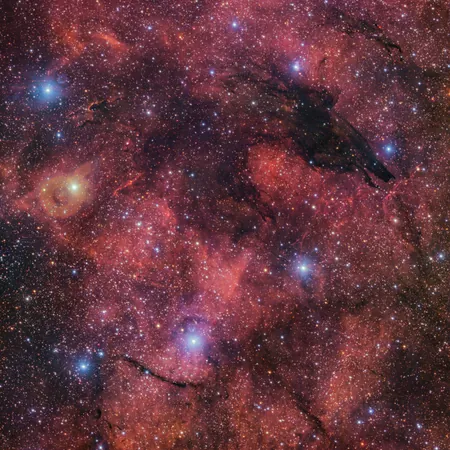
Intriguing Discovery: Astronomers Capture the ‘Dark Wolf Nebula’ in Stunning Detail!
2024-11-02
Author: Arjun
Introduction
Astronomers have recently stunned the scientific community and skywatchers alike with a breathtaking image depicting a giant cloud of gas and dust in space that resembles a wolf’s silhouette against a vibrant cosmic backdrop. This mesmerizing formation is referred to as the Dark Wolf Nebula and is located in the Scorpius constellation, approximately 5,300 light-years from Earth.
The Dark Wolf Nebula
Occupying a sky area equivalent to four full moons, this striking nebula is actually a section of a much larger structure known as Gum 55. Upon closer inspection, some viewers may even perceive the figure as a fearsome werewolf, with claw-like hands reaching outward from the depths of space!
Dark Nebulae and Their Significance
Dark nebulae, like the Dark Wolf, are composed of cold clouds of interstellar dust that are dense enough to obscure light from stars and other celestial objects behind them. This means that they act as a shroud over the universe, hiding the beauty of distant stars from view. The dust grains within these cosmic clouds predominantly absorb visible light, allowing only longer wavelengths like infrared light to emerge, thus providing a window into their true nature.
Capturing the Dark Wolf Nebula
These intriguing clouds attract the attention of astronomers because they often harbor new stars in the process of formation. The new image, which boasts an incredible 283-million pixels, was captured by the VLT Survey Telescope (VST) at the European Southern Observatory’s Parañal Observatory in Chile. It showcases the Dark Wolf Nebula in meticulous detail, enabling observers to appreciate how this dark entity stands out against the luminous, star-forming clouds surrounding it.
The Cosmic Surroundings
The colorful clouds surrounding the Dark Wolf are primarily composed of hydrogen gas, glowing in vibrant red hues due to intense ultraviolet radiation emitted by the newborn stars within. Researchers compiled the stunning picture using images captured at various times, each filtered to allow different colors of light to shine through.
Conclusion
This captivating discovery not only deepens our understanding of star formation and the structure of the universe but also ignites the imagination of all who gaze upon it. Enthusiasts and experts alike are drawn to the cosmic beauty of the Dark Wolf Nebula, and scientists are excited to explore the numerous secrets that this celestial formation may still hold. What other mysteries lie hidden in the cosmic expanse? Only time—and more advanced telescopes—will tell!




 Brasil (PT)
Brasil (PT)
 Canada (EN)
Canada (EN)
 Chile (ES)
Chile (ES)
 España (ES)
España (ES)
 France (FR)
France (FR)
 Hong Kong (EN)
Hong Kong (EN)
 Italia (IT)
Italia (IT)
 日本 (JA)
日本 (JA)
 Magyarország (HU)
Magyarország (HU)
 Norge (NO)
Norge (NO)
 Polska (PL)
Polska (PL)
 Schweiz (DE)
Schweiz (DE)
 Singapore (EN)
Singapore (EN)
 Sverige (SV)
Sverige (SV)
 Suomi (FI)
Suomi (FI)
 Türkiye (TR)
Türkiye (TR)